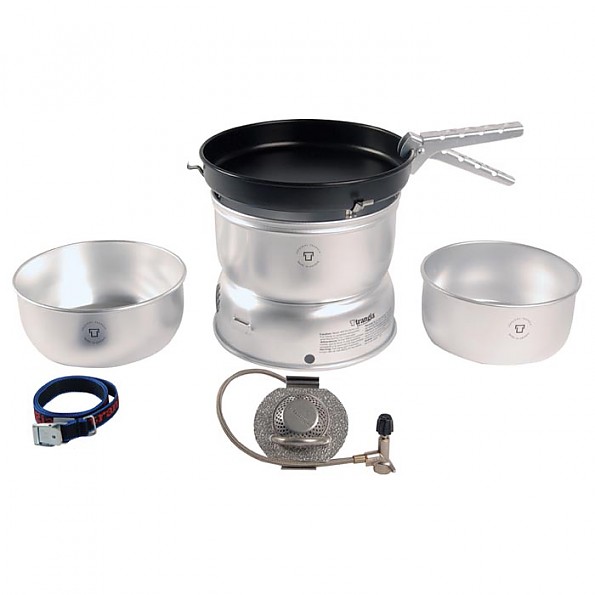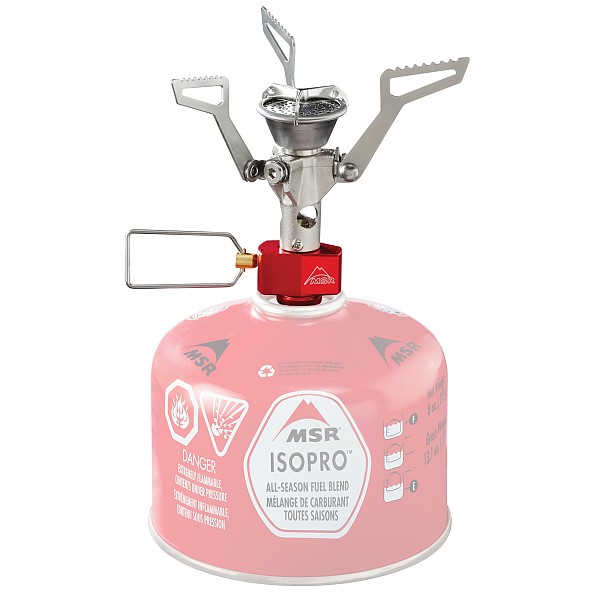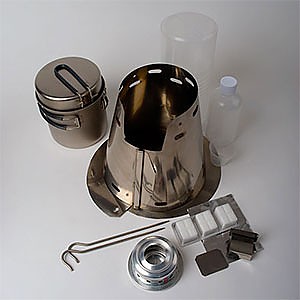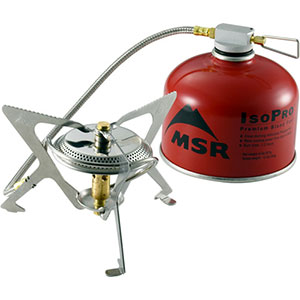Liquid Fuel Stoves
Liquid fuel stoves burn white gas, which is stored in a refillable fuel bottle and connects to the stove burner via a hose. You pump up the bottle to pressurize the fuel, which means these stoves can continue to work well in the cold. Liquid-fuel stoves are best for year-round use, and large group cooking
On This Page
Top Picks
How we choose: The best liquid fuel stoves highlighted here were selected based on 510 reviews of 60 products. Our top picks are those that are readily-available in the United States and have received the highest overall ratings from reviewers.
How we test: Trailspace is powered entirely by our community of readers. The reviews posted here reflect the real-world experiences of outdoor enthusiasts just like you.
If you've used a liquid fuel stove that you think should be listed here, please share your experience.
Disclosure: Trailspace never accepts payment for gear reviews, product placement, or editorial coverage. When you buy through affiliate links on our site, Trailspace may earn a small commission, which helps cover the costs of running the site.
MSR XGK-EX
Excellent stove for boiling water and fast cooking I have used this stove in the Beartooth Wilderness of Montana and the Porcupine Mountains in Michigan. I was able to turn the stove low enough that I could cook eggs and pancakes with it, but that is really pushing the stove on the low end. If you need to simmer a pot of gourmet gumbo, look into the MSR Dragonfly instead. I highly recommend this stove and have never been let down by any MSR product.
Reasons to Buy
- Hot and fast
- Burns anything
- Primes easily
Reasons to Avoid
- Weight
- Can't simmer
Stove sets up easily. Just thread the pump into the bottle, connect the fuel line, and it is ready to light. It doesn't have a built-in lighter, but I have never had an issue lighting it with a match. The flame is slightly adjustable, but don't count on this stove to simmer. This is primarily a water boiling stove, but I have used it for pancakes, eggs, and bacon with desirable results. Boil time with white gas was about 9 minutes for 2.5 liters of water in a real world test. This is very close to the claimed times.
Read more: MSR XGK-EX reviews (13)
Optimus Svea 123
The seva 123 is widely known as one of the most reliable stoves ever made and for good reason, they don’t break and most of them are still around in some form or another (parts, tarnished or new in box). The svea has been around for over half a century now and is still available new which can really attest for its quality and customer loyalty. Mine is an older Optimus model, and is missing the aluminum cup so I cannot speak as to the cup's performance. I still enjoy taking this stove on day hikes to cook some ramen noodles or Meso soup, plus it will get you some props from the older trail mates.
Reasons to Buy
- Always works
- Tuff as nails
- Fuel efficent
- Lightweight 15oz full
Reasons to Avoid
- Sometimes difficult to prime
- Brass tarnishes easily
- Dosen't carry much fuel
- Poor flame control
- Rather unstable
Story I found this stove completely by accident when I was cleaning out the basement; I found a milk crate full of old hiking gear. So I drug it out into the sunlight and inspected the contents and was amazed. Inside there were 20 unused Gaz canisters with matching stove, a Whisperlite, fold up candle lantern and the svea 123. Evidently it had been sitting in that crate for 20 years with all the other gear so first thing I did was fill it up with Coleman fuel fill the priming cup and torch it off.
Read more: Optimus Svea 123 reviews (61)
MSR WhisperLite Universal
Finally here is a true multi-fuel (MSR calls it a hybrid) stove that burns both liquid fuels and canister gas (upright or inverted). Not only does it burn these fuels, but it does it well — plus it simmers...no it really does! In just a couple minutes the stove can be configured to burn the various fuels (see below) by simply changing a couple parts using the supplied tool. This is a great option for anyone who wants a stove that can be used year round in multiple climates, with multiple fuels. For groups it allows flexibility through the use of multiple fuels — or for those who travel abroad to places where some fuels may be harder to get or if it's not clear what fuels will be available. The Universal will burn: White gas – Unleaded auto gas – Kerosene Canister gas – (upright or inverted)
Reasons to Buy
- Multi-fuel (liquid and canister)
- Everything is included
- Changing fuel types is quick
- Well built / sturdy
- Will handle large pots
- Good windscreen
- Simmers well
- Instructions easy to understand / follow
Reasons to Avoid
- Price point
- Weight
- Small parts to keep up with
- Will not support pots smaller than 4 ¼ in. or 11 cm. in diameter.
- Fuel line is stiff
A review of the MSR Whisperlite Universal Hybrid fuel stove A backpacking stove made by Cascade Designs – Seattle WA, USA I received this stove from Cascade Designs for testing and used it on five separate outings as well as a lot of testing at home. Stove Description: The stove arrived in a nice looking cardboard package (see photos), it included the stove, all parts for changing fuel types, pressure pump for liquid fuel bottles, canister stand, wind screen and ground protector, a nice stuff sack, and full instructions in three languages (three separate booklets) plus a quick reference guide in two languages, along with warnings etc.
Read more: MSR WhisperLite Universal reviews (12)
MSR DragonFly
After having my isobutane become unusable at temperatures below -30° C., I purchased this stove for winter trips. It is loud but there is a reason for that and that is it is creating huge amounts of heat.
Reasons to Buy
- Excellent in cold weather
- Can simmer, so it's great for the chefs
- Multiple fuels can be used
- Massive amounts of heat
Reasons to Avoid
- Loud, literaly sounds like a jet
- Big and heavy
The MSR Draonfly has been around for years. It is a tried and true expedition stove. It works on multiple different fuels from white gas, jet fuel, diesel, kerosene and gasoline. It will work in all temperatures and at all altitudes. I bought the stove after struggling in colder temperatures to get my isobutane stove to work properly and this stove had no trouble in temperatures below -30° C. It is great at melting snow for water and can boil a liter in less than 4 minutes. The stove has a large pot stand that can easily accommodate large pots and pans with great stability.
Read more: MSR DragonFly reviews (46)
Explore more top-rated liquid fuel stoves from MSR:
Primus OmniLite TI
Lightweight but true expedition-grade stove for use on numerous types of fuel, regardless of the country where you are. In the meantime it’s well suitable for all people who often cook in cold weather and disregard the canister gas.
Reasons to Buy
- Proven Omnifuel design (just scaled down)
- Expedition-grade durability even for most challenging conditions
- Very low tendency to clogging, easy to clean
- Works well on most fuels you may encounter
- Very small and lightweight for such a stove
- Just 10% less powerful than Omnifuel
Reasons to Avoid
- Awkward, heavy, and useless soft case
- Roaring sound
- Not very durable pump
- No “automatic” cleaning needle
- Fuel sprays when disconnecting the pump from the bottle
I’ve been using this stove since 2013 in all my outdoor adventures. The primary fuel is white gas in domestic trips and car petrol in international trips (for me finding the gas canisters or white gas in unfamiliar country is a waste of precious time). My primary stove in 2008-2013 was Primus Omnifuel, which I liked very much despite its weight and size. There are two main reasons to use the multifuel stove instead of regular gas stove: Performance at low temperatures. If you cook at temperatures below +10 °C (50 °F) and ESPECIALLY below the freezing, the gas stoves are not a good choice for you.
Read more: Primus OmniLite TI reviews (3)
Coleman 533
Rugged stove that works well under all conditions. Easy to use but can be finicky in adjusting the flame.
Reasons to Buy
- Rugged
- Easy lighting
- Durable
- Size
Reasons to Avoid
- Cost (2024) is pricey, over $100—I paid $35 a while ago.
- Replacement parts still available.
- Large coffee pot can be unstable.
My Coleman 533 is about 30 years old. Used frequently on camping trips to perk coffee and cook simple meals. Lighting the stove is easy. If the stove is full, frequent pumping is necessary until fuels burns off to maintain a larger air volume in the tank. The flame control does not work all that well. The low heat "sweet spot" is hard to find and if you don't monitor it, the flame will go yellow and the stove will go out. A full large coffee pot has a tendency to be unstable due to the small footprint over the burner.
Read more: Coleman 533 reviews (5)
Optimus Polaris Optifuel
Well built. Needs an additional silencer cap to achieve its potential.
Reasons to Buy
- Solid build
- Excellent pump
- Innovative, easy and quick way to de-clog the jet
- Compact
- Easy to service
Reasons to Avoid
- Very loud without silent cap
- Poor performance with canister gas
- Tendency to pulse
I bought this recently as an alternative to my Coleman 442 and to replace a Primus Omnilite. I tested it with its normal flame spreader boiling half a litre of water with canister gas, white gas, and kerosene. Apart from being very loud, which I expected, I found the performance on canister gas disappointing. It took a full minute longer than the other fuels to boil half a litre, and simmer control was poor, having a tendency to go out altogether when turned low. On white gas and kerosene, it was considerably better, although pulsing occasionally. The Polar Dawg silent cap, though expensive, transformed the stove.
Read more: Optimus Polaris Optifuel reviews (2)
Coleman Peak 1 Feather 400
A bit on the heavy side, but a bomb-proof reliable backpacking stove.
Reasons to Buy
- Well built
- Bomb proof
- 20 plus years hassle free
Reasons to Avoid
- Heavy, 2 pounds with fuel
- Parts hard to find now
- No longer made
Other than the weight, this stove is a dream. It isn't made anymore, but they do make newer versions. I have used this stove trouble free since 1991. It has been on countless backpacking, cycling, and kayak trips, some as long as 14 days (one bike trip to California was actually 2 months of daily use). I don't mind carrying a bit more weight considering how reliable this is. My stove is always kept in a padded bag, and a plastic bag to keep debris out of it. Even using a wind screen I have never had a boil over.
Read more: Coleman Peak 1 Feather 400 reviews (5)
Optimus 111B
It is rare in today’s outdoor market for a product to continue with few changes for more than a score of years or even a decade. Stoves are a bit different, requiring more R & D, as well as being based on a couple of basic designs. The Optimus 111B is a design that dates in nearly unchanged form to the 1920s and still performs well to this day.
Reasons to Buy
- Requires minimal assembly
- Boils water quickly
- Stable
- Able to use large pots
- Precise flame control
- Extremely reliable
Reasons to Avoid
- Expensive
- Heavy
- Only available used
- Roarer burner is noisy
Background: Early pressurized stoves date back to the late 19th century. No one can say for certain who developed the first one, but by the end of the century Optimus was one of the leading names. Those early stoves used kerosene (parafin), but by the early 20th century white gas (Coleman Fuel, naphtha) was becoming more common. In 1927, Optimus of Sweden patented their No. 11, a box stove that would burn either white gas or kerosene. It was encased in a tin box with a brass fuel tank and a simple roarer type burner.
Read more: Optimus 111B reviews (4)
Primus OmniFuel
There is only one thing preventing this stove from being perfect and that is the fact that it is a roarer burner: the jet of fuel is spread out onto the pan's surface by hitting a metal concave cover on the way up. Other than that, there is very little to fault it. The pump shaft is metal, not plastic (I know several people who have broken MSR pumps and sometimes have had to buy the entire pump assembly again). I have stood on this stove a couple of times and each time the legs just bend back into place.
Read more: Primus OmniFuel reviews (21)
More Reviews of Liquid Fuel Stoves
Trailspace reviewers have shared 510 reviews of 60 different liquid fuel stoves.
or add yours
How to Choose a Liquid Fuel Backpacking Stove
What should I consider when choosing a liquid stove?
- Fuel Efficiency: How much water can you boil or food can you cook, for a given volume of fuel?
- Ignition: How easy is to prime or light? Does any built-in igniter work well consistently?
- Setup: How easy is the stove to setup and fuel?
- Flame Control: Is the burner adjustable? If so, how well?
- Cooking: How well does the stove let you boil, simmer, fry, bake, etc.?
- Boil Time: How long does it take to boil water in sheltered conditions?
- Wind: Does the stove stay lit in wind? How does wind affect boiling time? Is there a windscreen?
- Stability: Is it stable and secure with a pot, or a potential "noodle-dumper"?
- Packability: How well does the stove pack away and store?
- Ease of Use: Do parts and features work as expected? Consistently?
- Field Maintanable?
What are the advantages of a liquid fuel stove?
- works consistently in cold or hot temperatures
- fuel is less expensive than canisters
- fuel is easy to obtain around the world
- fuel bottle is refillable for less waste
- you know how much fuel is in the bottle
Are there any downsides?
- can be heavy and bulky
- have to pump up
- need to prime
- need to maintain
- can be dangerous
What specific fuels do these stoves burn?
Liquid-fuel stoves burn white gas. Not all liquid-fuels are recommended for or can be used in all stoves, even multi-fuel models:
- White gas/petroleum Naphtha: the standard and most recommended choice, white gas burns cleanest; it is also available under brand names, for example MSR SuperFuel, Coleman Fuel, Primus Gas
- Coleman Fuel: a petroleum naphtha product marketed by the Coleman Company
- Kerosene: aka paraffin oil, is available around the world, it's also dirty and stinky, and the quality can be unknown
- Diesel: it's dirty and stinky, and not all multi-fuel stoves that run white gas and kerosene can use diesel; check your instructions.
- Avgas/aviation gasoline: Jet fuel:
- Unleaded Automotive Gasoline: aka petrol; the additives in car gas can muck up your stove, and any ethanol/alcohol in the gas can corrode your fuel bottle; if in need, use unleaded
What are the best liquid-fuel stoves?
Check out the top-rated liquid stoves above for Trailspace reviewers' recommendations. Then review your own stoves and add to that expertise.
Who invented the liquid-fuel stove?
In the 1890s, Carl Richard Nyberg inventor of the blowtorch, began manufacturing Primus gas stoves. The first model, was called the Viktoria and was not very successful, but the later Svea did better. Frans W Lindqvist is also credited for designing gas stoves at the same time.
How do I stay safe?
To prevent injury, always consult and follow your stove manufacturer’s fuel recommendation and stove instructions. Always use stoves in a safe, well-ventilated, outdoor area. Be aware of any fire bans and rules. Practice Leave No Trace.
Other Types of Backpacking and Camp Stoves
Find more backpacking and camp stoves reviewed in these related categories:

Alcohol Stoves

Compressed Fuel Canister Stoves

Multi-Fuel Stoves

+6 more types
Review Your Outdoor Gear
If you've found this site helpful — or if we've missed something important — please consider paying it forward by some of your favorite outdoor gear.
Why? From professional gearheads to outdoor novices, everyone has an important point of view to contribute. will support the outdoor community and help others find the best gear.
Trailspace reviewers are outdoor enthusiasts like you: hikers, climbers, paddlers, backcountry skiers, and trail runners who share our experiences with the gear and clothing we rely on to get outside. Learn more about Trailspace




